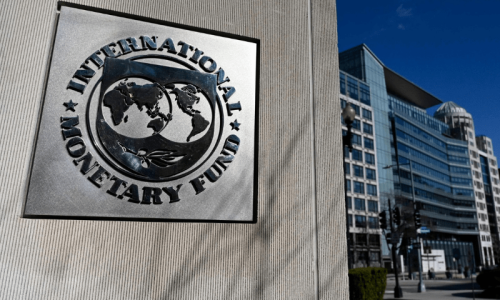To secure an International Monetary Fund (IMF) loan of $6 billion, Finance Minister Muhammad Aurangzeb has repeatedly emphasised that Pakistan’s tax-to-GDP ratio, currently at 9 per cent, is inadequate to sustain the country. He has expressed a firm commitment to increasing this ratio to 13pc within the next three years.
Regrettably, neither he nor any other senior government official has demonstrated a similar level of commitment and dedication to raising the country’s exports-to-GDP ratio (exports of goods and services as a percentage of GDP), which currently stands at around 10.4pc. Many economists believe that increasing this ratio to 15pc could potentially obviate the need for an IMF loan or external borrowing to address the balance of payments crisis.
In 1990, Pakistan’s exports-to-GDP ratio was around 14.8pc, which was significantly higher than that of China, India, and Bangladesh. Over the last three decades, these countries have predominantly experienced export-led growth, resulting in increased exports-to-GDP ratios of 19.7pc, 21.9pc, and 13.2pc, respectively, in 2023, as per World Bank data.
Unfortunately, due to flawed economic policies and the misplaced priorities of successive governments, Pakistan has bitterly failed to achieve export-led growth. Particularly during the Nawaz Sharif regime (2013-2017), the dollar exchange rate was artificially capped at Rs100 for four years. This policy made imports cheaper, leading to a surge in imports while exports declined.
Pakistan’s potential for sustainable growth in agri-food exports hinges on its ability to generate a significant surplus
In fact, the policy shook the very foundation of Pakistan’s export sector and disrupted the value chains of exportable products. While the intention was to keep inflation in check and to win the country’s next election — a short-term political gain — it came at the expense of long-term export growth. Consequently, Pakistan transitioned to a consumption-based economy, and the business community shifted its investment focus from manufacturing to trading and real estate sector.
The government, however, continued to collect taxes and duties on imports — a hassle-free method of tax collection and boosting revenue — without acknowledging that it came at the cost of a massive current account deficit. As a result, Pakistan’s export-to-GDP ratio decreased from 12.2pc in 2013 to 8.2pc in 2017, according to World Bank data.
Now, with the exception of some niche markets, Pakistan is struggling to increase its exports. The manufacturing sector feels incapacitated in maintaining its competitiveness in global markets due to a high policy rate of 20.5pc, electricity costs three times higher than those in neighbouring countries, and, to top it all off, frequently changing trade policies and tax regimes.
Historically, our manufacturing sector, particularly the textile sector, has relied on the government’s subsidies and incentives, which have hindered productivity, product diversification, and product quality improvements to the level needed to compete in global markets.
As the government withdraws these tax-related concessions and other incentives due to the financial crisis, manufacturers and exporters openly state that they will relocate their businesses to other countries, offering better incentives and a business-enabling environment.
However, amidst these economic challenges, the business environment, and current government policies, agriculture and information and communication technology (ICT) are the two sectors that can be relied upon for export growth, even during the current economic stabilisation phase.
Agriculture and IT are relatively less capital-intensive and do not require significant energy inputs. Their electricity needs can be efficiently met through solar power for offices and tube wells. Moreover, contrary to manufacturing, their turnaround period is in months, not years.
These sectors also offer another significant advantage: unlike the manufacturing sector, they are not heavily reliant on imports. Consequently, when they export, there is no corresponding considerable increase in imports.
In the agriculture sector, exports are primarily commodity-based and mostly competitive in price. The agriculture sector does not require substantial capital-intensive interventions to gear up for exports. By simply using high-yielding certified and climate-resilient seeds, ensuring the recommended plant population, applying fertilisers in the required quantities and proportions, increasing cropping intensity with the use of short-duration seed varieties, and ensuring a cost-plus pricing structure for crops — a prerequisite for the financial viability in farming — the agriculture sector can unlock its immense potential in the short-term. This will allow it to produce additional volumes for import substitution as well as to create export surpluses.
According to the Trade Development Authority of Pakistan (TDAP), agri-food exports of Pakistan reached $8bn in FY24, which is 37pc higher than last year. This surge is mainly due to remarkable growth in the exports of rice, maize, sesame, meat, and onion. However, these exports were not part of a deliberate plan; instead, they resulted from farmers’ decisions to cultivate these crops extensively, driven by their relatively better financial prospects.
Therefore, to boost agricultural exports sustainably, the country needs a robust policy coupled with a comprehensive strategy and an effective institutional framework for implementation and monitoring. A well-structured policy can provide the government entities with a clear direction, roadmap, and framework to undertake essential measures proactively for increasing the access and competitiveness of the prioritised list of the agricultural products — both traditional and non-traditional — in conventional as well as untapped international markets.
In conclusion, Pakistan’s potential for sustainable growth in agri-food exports hinges on its ability to generate a significant export surplus. Achieving this goal requires two key strategies: bridging existing gaps in productivity and crop yields viz-a-viz comparable countries and increasing cropping intensity, which currently stands at 1.59.
Khalid Wattoo is a farmer and a development professional.
Dr Waqar Ahmad is a former Associate Professor at the University of Agriculture, Faisalabad.
Published in Dawn, The Business and Finance Weekly, July 15th, 2024















































Dear visitor, the comments section is undergoing an overhaul and will return soon.